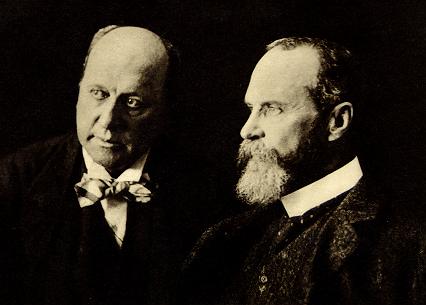"Don’t Get Carried Away Now! by Edward Hugh
As Paul Krugman recently pointed out, one of the key points to be found in the latest IMF World Economic Outlook was that recessions caused by financial crises tend to get resolved on the back of export-lead booms, with countries normally emerging from the crisis with a trade balance of more than 3 percent of GDP. The reason for this is simple, since consumers are so laden-down with debt from the boom period, they are naturally more obsessed with saving than borrowing during the initial crisis aftermath. So much for the typical crisis then, and the typical exit. But musing on this point lead Krugamn to a rather the disturbing conclusion: given the truly global character of the present financial crisis, the habitual exit route to recovery will only work after we are able to identify another planet to send all those exports to (shades of Startreck IV). The joke may seem a rather exaggerated one, in poor taste even, but behind it there lies a little more than a grain of truth.
But not everywhere is gloom and doom at the moment, and on the other side of the world they woke up reeling from another kind of bounce last Monday morning, the one they experienced on learning that India’s outgoing government had been not only been re-elected, but had come back into power on a much more stable basis. And that was not the only pleasant surprise in store for those reading the morning newspapers in London, Madrid or New York, since India’s main stock index - the Sensex - shot up as much as 17% during early trading on receiving the news, while the rupee also surged sharply. So just one more time we find ourselves faced with the prospect of living in a rather divided world, where on one side we have growing and deepening pessimism, while on the other we see a burst of optimism, with someone, somewhere, getting a massive dose of that “let a thousand green shoots bloom” kinda feeling. Perhaps we should ask ourselves whether there is any connection?
Well, and to cut the long story short, yes there is, and the connection has a name, and it’s called sentiment. Indeed sentiment is precisely why the recent (and highly controversial) US bank stress tests were so important. Their real significance was not for any relevance they may have from a US banking point of view (which was, of course, highly contested), but for the reassurance they can give market participants that there will not be another financial explosion in the United States (as opposed to a protracted recession, and long slow recovery), or put another way, to show the days of “safe haven” investing are now over. Risk is about to make a comeback, and the only question is where?
Which brings us straight back to all that earlier talk of coupling, recoupling, decoupling, and uncoupling which we saw so much of a year or so ago. And to the world as we knew it before the the demise of Lehmann brothers, where commodity prices were booming like there was no tomorrow on the one hand, while credit- and housing-markets markets were steadily melting down in the developed economies on the other, where growth was being clocked up in many emerging economies at ever accelerating rates, while the only shoots we could see on the horizon in the US, Europe and Japan were those of burgeoining recessions.
The point to note here is not just that a significant group of investors and their fund managers were busily adapting their behaviour to changed conditions in the US and Europe, but rather that a very novel set of conditions began to emerge, as the credit crunch worked its way forward and property markets drifted off into stagnation in one OECD economy after another. Just as they were finally announcing closing time in the gardens of the West almost overnight it started “raining money” in one emerging economy after another - as foreign exchange came flooding in, and the really hard problem for governments and central banks to solve seemed to be not how to attract funding, but rather how to avoid receiving an excess of it. Thailand even attained a certain notoriety by imposing capital controls with the explicit objective of discouraging funds not from leaving but from entering the country.
Then suddenly things moved on, and day became night just as quickly as night had become day as one fund flow after another reversed course, and the money disappeared just as quickly as it had arrived. Behind this second crunch lay an ongoing wave of emerging-market central bank tightening (during which Banco Central do Brasil deservedly earned its spurs as the Bundesbank of Latin America) which lead one emerging economy after another to wilt under the twin strain of stringent monetary policy and sharply rising inflation. By November all those previous positive expectations were being sharply revised down, with the IMF making an initial cut in its global growth estimate for 2009 - to 2.2 percent from the 3.7 percent projected for 2008. The World Bank went even further, and by early December was projecting that world trade would fall in 2009 for the first time since 1982, with capital flows to developing countries being expected to plunge by around 50 percent. By March 2009 they were estimating that the volume of world trade, which had grown by 9.8 percent in 2006 and by 6.2 percent in 2007, was even likely to fall by 9 percent this year.
Having said this, and while fully recognising that the future is never an exact rerun of the past - and especially not the most recent past - given that emerging economies have been the key engines of global growth over the last five years, is there any really compelling reason for believing they won’t continue to be over the next five? Could we not draw the conclusion that what was “unsustainable” was not the solid trend growth which we were observing between 2002 and 2007, but rather the excess pressure and overheating to which the key EM economies were subjected after the summer of 2007? And if that is the case, might it not be that the “planet” we need to find to do all that much needed exporting isn’t so far away after all, but right here on this earth, and directly under our noses, in the shape of a growing band of successful emerging economies.
According to IMF data, the so called BRIC countries actually accounted for nearly half of global growth in 2008 - China alone accounted for a quarter, and Brazil, India and Russia were responsible for another quarter. All-in-all, the emerging and developing countries combined accounted for about two-thirds of global growth (as measured using PPP adjusted exchange rates) . Furthermore, and most significantly, the IMF notes that these economies “account for more than 90 per cent of the rise in consumption of oil products and metals and 80 per cent of the rise in consumption of grains since 2002”.
But behind the recent emerging market phenomenon what we have is not only a newly emerging growth rate differential, alongside this we have also seen large scale and ongoing currency re-alignment taking place, a realignment driven, as it happens, by those very same growth rate differentials. The consequential rapid and dramatic rise in dollar GDP values (produced by the combination of strong growth and a declining dollar) has meant that a convergence in global living standards - at least in the cases of those economies who have been experiencing the strongest acceleration - has been taking place much more rapidly than anyone could possibly have dreamed back in the 1990s, even if the long term importance of this is currently being masked by the recent collapse in commodity values and the downward slide in emerging currencies associated with this and the wekening in risk appetite.
Carry On Trading
But now we have a new factor entering the scene. The US Federal Reserve, along with many of the world’s key central banks, has so reduced interest rates that they are running only marginally above the zero percent “lower bound”, and the Fed is far more concerned with boosting money supply growth to fend of deflation than it is with restraining it to combat inflation. Not only that, Chairman Ben Bernanke looks set to commit the bank to maintain rates at the current level for a considerable period of time.
In this situation, and given the extremely limited rates of annual GDP growth we are likely to see in the US and other advanced economies in the coming years, such liquidity provision is very likely to exit the first world looking for yield, and where better to go than to those high yield emerging market economies.
The Federal Reserve could thus easily find itself in the rather unusual situation of underwriting the nascent recovery in emergent economies like India and Brazil , just as Japan did during the period of its experiment with quantitative easing between 2001 and 2006. And the mechanisms through which the money will arrive? Well, they are several, but perhaps the best known and easiest to understand of them is the so called carry trade, which basically works as follows.
Stimulus plans and near-zero interest rates in developed economies boost investor confidence in emerging markets and commodity-rich nations who have interest rates which are often in double figures. Using dollars, euros and yen these investors then buy instruments denominated in currencies from countries like Brazil, Hungary,Indonesia, South Africa, New Zealand and Australia - which collectively rose around 8% from March 20 to April 10, the biggest three-week gain for such trades since at least 1999 . A straightforward and simple carry-trade transaction would be to borrow U.S. dollars at the three-month London interbank offered rate of 1.13% and use the proceeds to buy Brazilian real and earn Brazil’s three-month deposit rate of 10.51%. That would net anannualized 9.38% - as long as both currencies remain stable, but the real, of course, is appreciating.
Other options are Turkey, where the key interest rate is currently 9.25 percent, Hungary (9.5 percent) and Russia’s (12 percent). The cost of borrowing in euros overnight between banks reached 0.56 percent last week from 3.05 percent six months ago as the European Central Bank cut interest rates while pledges of international aid reduced concern the global recession would worsen. The London interbank offered rate, or Libor, for overnight loans in dollars fell to 0.22 percent from 0.4 percent in November.
Indeed Deustche Bank last week specifically recommended buying Hungarian forint denominated assets, and according to the bank the Russian ruble, the Hungarian forint and the Turkish lira are among trades offering investors the best returns over the next two to three months. Deutsche Bank recommends investors sell the euro against the forint on bets the rate difference will help the Hungarian currency gain 10 percent to 260 per euro in two to three months from 286.55 today. Investors should also sell the dollar against the lira and buy the ruble against the dollar-euro basket, the bank said. And it isn’t only Deutsche Bank, at the start of April Goldman Sachs also recommended investors to use euros, dollars and yen to buy Mexican pesos, real, rupiah, rand and Russia rubles. And Barclays joined the pack this week saying Brazil’s real, South Africa’s rand and Turkey’s lira offer the “largest upside” as investors return to the carry trade. A global pickup in investor demand for higher-yielding assets and signs the worst of the global recession is over “bode very well for the comeback of the emerging-market carry trade,” according to analyst Anfrea Kiguel in a recent report from New York. In part as a result of the surge in carry activity the US dollar declined beyond $1.40 against the euro on Friday for the first time since January. Evidently the US may now be headed down a path which is already well-trodden by the Japanese yen.
India on The Up and Up.
But some of these trades are much riskier than others. Many of the countries in Eastern Europe who currently offer the highest yields are also subject to IMF bailout programmes, so they are with good reason called “risky assets”. But others look a lot safer. Take India for example. As Reserve Bank of Indian Governor Duvvuri Subbarao stressed only last week, India’s “modest” dependence on exports will certainly help the economy weather the current global recession and even stage a modest recovery later this year. Of course, “modest” is a relative term, since even during the depths of the crisis India managed to maintain a year on year growth rate of 5.3 percent (Q4 2008), and indeed as Duvvuri stresses, apart from the limited export dependence, India’s financial system had virtually no exposure to any kind of “toxic asset”.
As mentioned above, the rupee rose 4.9 percent this week to 47.125 per dollar in Mumbai, its biggest weekly advance since March 1996, while the Sensex index rallied 14 percent for its biggest weekly gain since 1992.
And, as if to add to the joy, even as Indian Prime Minister Manmohan Singh began his second term, and stock markets soared, analysts were busy rubbing their hands with enthusiasm at the prospect that the new government might set a record for selling off state assets, and thus begin to address what everyone is agreed is now India’s outsanding challenge, reducing the fiscal deficit.
Singh, it seems, may well sell-off anything up to $20 billion of state assets over the next five years as he tries to reduce the central govenment budget shortfall. At the present time India’s Congress party-led coalition faces a central government fiscal deficit which is running at more than double the government target - it reached 6 percent of gross domestic product in the year ended March 31, well beyond the 2.5 percent government target. The prospect of a wider budget gap prompted Standard & Poor’s to say in February that India’s spending plans were “not sustainable” and the nation’s credit rating may be cut again if finances worsen. But simply raising 100 billion rupees from share sales and initial public offerings in the financial year that began last April 1 would cut the fiscal deficit by an estimated quarter-point.
As a result of this perception that the new Indian government will seriously address the fiscal deficit situation, stocks rose sharply this week, with the benchmark index posting a 14 percent rise, its largest weekly gain in 17 years, on speculation the ruling party will accelerate economic reforms.
And it isn’t only India which is exciting investors. Brazil’s central bank President Henrique Meirelles went so far as to warn this week against an “excess of euphoria” in the currency market, implicitly suggesting the bank may engage in renewed dollar purchases to try to slow down the three-month rally in the real. The central bank began buying dollars on May 8, while Meirelles’s comments this week were seen as an additional measure to upgrade the level of verbal intervention. The real has now climbed 20.5 percent since March 2, the biggest advance among the six most-traded currencies in Latin America, as prices on the country’s commodity exports rebounded and investor demand for emerging-market assets has grown. The currency is up 14 percent this year, more than any other of the 16 major currencies except for South Africa’s rand, reversing the 33 percent drop in the last five months of 2008.
Conclusions
Despite a number of outsanding worries about the emerging economies in Eastern Europe, the general idea that countries like India, Brazil, Turkey, Chile, Peru are up towards the top of the list of economies where growth conditions are, relatively, the most favorable seems essentially sound. Additionally if this sort of argument has any validity at all, it is bound to have implications for one of the key problems which we will face in the context of the next global upturn: what to do with the financial architecture which we have inherited from the original Bretton Woods agreement (or Bretton Woods II as some like to call it).
The limitations of the current financial architecture have become only too apparent during the present recession, since with both the Eurozone and the US economies contracting at the same time, the currency see-saw between the dollar and the euro has failed to provide any adequate form of automatic stabiliser. And since Japan is in an even more parlous state, deep in recession, and desparate for exports, it is having to live with a yen-dollar parity which is at levels not seen since the mid 1990s. This has lead some analysts to start to talk of a new and enhanced role for China’s currency, the yuan, and obviously beyond the yuan we could also consider the real and the rupee, but I would like to suggest the problem we now face is a much broader one, and it concerns how to conduct monetary policy in an age of global capital flows.
The euro hit 1:40 to the USD yesterday (at a time when Europe’s economies are in deeper recession than the US one is), while Brazilian central bank President Henrique Meirelles felt the need to come out and warn against an “excess of euphoria” in the local currency market following an 18% rise in the real over 3 months. Turkey’s lira was also up and has now advanced 10 percent in the last three months, while South Africa’s rand is up 22 percent, making it the best performing emerging-market currency over the past three months.
All good “carry” punts these, since Turkey’s benchmark interest rate stands at 9.25 percent, compared with a range for overnight loans between banks of zero to 0.25 percent in the U.S. Brazil’s benchmark interest rate is 10.25 percent. Even the ruble is up sharply, as Russia’s economy struggles to handle growing default rates. The currency climbed to a four-month high against the dollar yesterday, making for its longest run of weekly gains in almost two years, hitting 31.0887 per dollar at one point, its strongest level since Jan. 12. The currency was up 3.2 percent on the week, thus closing its sixth weekly advance and extending its longest rally since September 2007. The ruble has in fact now climbed 16 percent since the end of January. Russia’s has cut base interest rates twice since April 24 in an attempt to revive the economy, but the refinancing rate is still 12 percent - well above rates in the EU, the U.S., Japan and even quite attractive in comparison with those on offer in other emerging markets. The basic point here is that carry trade players can leverage interest rate differentials and benefit from the changes in currency valuation that these very trades (along with those made by other participants) produce. So all of this is truly win-win for those who play the game, until, that is, it isn’t.
The issues presented by what is now happening are in many ways related to the one I started this article with: namely, who it is who will run the trade and current account deficits and do the necessary consuming which will make all those export lead recoveries possible. Evidently the main problem generated during the last business cycle was associated with the size of the imbalances it threw up. If I am right, we are just about to generate a further, and possibly even larger, set of such imbalances if we let the process rip in an uncordinated and unrestrained fashion. Floating Brazil and India is a very attractive and very desireable proposition. Consumers in those countries can take on more leveraging, and the countries can to some extent support external deficits as they develop. But they do not need distortions, and we do not need more Latvias, Estonias, Irelands or Spains. So policy decisions are now urgently needed to impose measures and structures which help avoid a repeat of the same in the near future."







































No comments:
Post a Comment